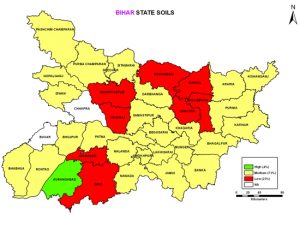
Bihar Soils
Introduction Soil is one of the most important resources on the earth. It is the great gift of nature of immense value. The most common use of soil is as the medium in which plants grow, although it has a different connotation at different time and place, and for persons engaged in different professions.
Apart from this most of the economic activities are directly or indirectly dependent on soil. Thus soil is the pivot of agricultural and industrial development of the world.
Soil has several characteristics, which may be regarded as the aggregate of the physical, chemical and biological properties.
Bihar plane made of a thick alluvial mantle of drift origin overlying in most part. The siwalik and older tertiary rocks.
The soil of Bihar is mainly young loam rejuvenated every year by constant deposition of silt, clay and sand brought by different streams.
This soils of Bihar deficient in phosphoric acid, nitrogen and humus, but potash and lime are usually found in optimum level.
Types of soils in Bihar
There are three essential sorts of soil in Bihar:
- Piedmont Swamp Soil – found in northwestern section of west Champaran district.
- Terai Soil – found in northern section of the state along Nepal border
- Gangetic Alluvium – covering the Bihar plains
We will discuss about these soil in detail:
Alluvial soil
Alluvial soils are framed primarily because of sediment saved by Indo-Gangetic-Brahmaputra streams. In beach front districts some alluvial stores are framed because of wave activity. Rocks of the Himalayas shape the parent material. Accordingly the parent material of these dirts is of transported starting point.
They are the biggest soil bunch covering around 15 lakh sq km or around 6 for each penny of the aggregate zone. They bolster over 40% of the India’s populace by giving the most gainful agrarian terrains.
Attributes of Alluvial Soils
They are youthful and have powerless profiles because of their current root.
The majority of the dirt is Sandy and clayey soils are normal.
Pebbly and gravelly soils are uncommon. Kankar (calcareous solidifications) beds are available in a few areas along the stream patios. The dirt is permeable as a result of its loamy (measure up to extent of sand and earth) nature.
Porosity and surface give great waste and different conditions positive for farming. These dirts are always recharged by the repetitive surges.
Synthetic properties of Alluvial Soils
The extent of nitrogen is by and large low.
The extent of Potash, phosphoric corrosive and alkalies are satisfactory
The extent of Iron oxide and lime change inside a wide range.
Crop Yields in Alluvial Soils
They are for the most part level and normal soils and are most appropriate for agribusiness. They are most appropriate to water system and react well to waterway and well/tube-well water system.
They yield magnificent harvests of rice, wheat, sugarcane, tobacco, cotton, jute, maize, oilseeds, vegetables and organic products.
Bhangar
The Bhangar is the more established alluvium along the stream beds framing patios higher than the surge plain (around 30 meters over the surge level).
It is of a more clayey structure and is for the most part dull shaded.
A couple of meters underneath the patio of the bhangar are beds of lime knobs known as “Kankar”.
Khadar
The Khadar is made out of fresher alluvium and structures the surge fields along the waterway banks.
The banks are overwhelmed practically consistently and another layer of alluvium is stored with each surge. This makes them the most fruitful soils of Ganges.
They are sandy dirts and topsoils, more dry and filtered, less calcareous and carbonaceous (less kankary). Another layer of alluvium is stored by stream surge practically consistently.
Terai Soil
Terai is a poorly depleted, soggy (mucky) and thickly forested limited tract (15-30 km wide) toward the south of Bhabar running parallel to it.
The underground surges of the Bhabar belt re-develop in this belt. It is a swampy marsh with silty soils. The terai soils are rich in nitrogen and natural issue yet are insufficient in phosphate.
These dirts are for the most part secured by tall grasses and woodlands however are reasonable for various harvests, for example, wheat, rice, sugarcane, jute and so forth. This thickly forested area gives asylum to an assortment of natural life.
Piedmont Swamp soil
This is the third prominent type of soil in Bihar. This soil is found in northwestern section of west Champaran district. It is has more features of swamp. Paddy cultivation in this type of soil is more prevalent.
BPCS Notes brings Prelims and Mains programs for BPCS Prelims and BPCS Mains Exam preparation. Various Programs initiated by BPCS Notes are as follows:-
- BPCS 2020 Mains (65th Mains) Tests and Notes Program
- BPCS Prelims Exam 2020 (66th Prelims)- Test Series and Notes Program
- BPCS Prelims and Mains 2020 Tests Series and Notes Program
- BPCS Detailed Complete Prelims Notes
